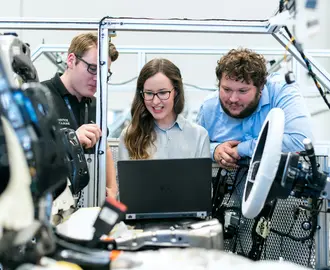Is it feasible for U.S. business executives to create better jobs for frontline workers in industries such as retail? Yes, but it’s not easy for companies—particularly publicly traded ones—to make the change.
That was one of the key overall takeaways from a recent event at the MIT Sloan School of Management featuring Zeynep Ton, an MIT Sloan Professor of the Practice in Operations Management who is also a faculty affiliate of the MIT Institute for Work and Employment Research (IWER). The event, “Making the Case for Good Jobs: A Fireside Chat with Zeynep Ton,” was held on February 29, 2024 and was sponsored by IWER and the MIT Sloan People and Organizations Club. The discussion was hosted by MIT Sloan Professor Erin L. Kelly, who is the Sloan Distinguished Professor of Work and Organization Studies at MIT Sloan as well as Co-Director of IWER. People and Organizations Club President Abhilasha Negi, MBA ’24, welcomed attendees to the discussion.
MIT Sloan Professor Zeynep Ton
During the event, Kelly interviewed Ton about Ton’s most recent book, “The Case for Good Jobs: How Great Companies Bring Dignity, Pay and Meaning to Everyone’s Work” (Harvard Business Review Press, 2023), and members of the audience followed up with additional questions.
Ton described how her early-career research in retail operations led her to observe the high cost of operational problems in retail stores. Her research identified some retailers, such as the convenience store chain QuikTrip and the warehouse club Costco, that had found ways to organize work differently, so that workers were more productive and, in return, earned significantly higher pay than is typical for retail. By studying such companies, Ton formulated what she calls the “good jobs system.” It involves a mix of people-management and operational choices: investing in people; organizing frontline work to create more standardization as well as more empowerment for workers; cross-training workers to make them more productive; simplifying and focusing operations to increase productivity; and operating with some slack so workers have time to serve customers well.
After Ton published her first book, “The Good Jobs Strategy,” in 2014, executives interested in adopting a good jobs strategy began to contact her, and she formed a nonprofit, the Good Jobs Institute, to work with such companies.
Here are a few highlights of what Ton has learned since then:
Many executives would like to offer their frontline employees better jobs but are daunted by the transition. “No executive I met…was proud of offering their employees unlivable wages, or providing poor working conditions,” Ton observed. “So many said, ‘We would rather operate like QuikTrip or Costco, but we don't think we can do it.’”
One big obstacle? Conventional business wisdom that treats employees as a cost to be minimized and considers market pay efficient. Paying market rate “might be great for soybeans, but maybe not for people when [poverty-level] pay reduces their…mental health, physical health, and cognitive functioning,” Ton said. She pointed out that no one will question a CEO’s decision to invest in, say, a digital transformation initiative, but they will question a decision to invest in frontline workers. For example, when Walmart’s CEO announced in 2015 that the company would raise its starting wages from $7.25 to $9 and then $10, the company’s stock price temporarily fell 10%. However, Ton noted, the stock price quickly recovered.
Another obstacle, according to Ton? A lack of systems thinking. Although MIT Sloan MBA students learn about the complexity of system dynamics, Ton raised a concern that in general, educators “have taught business leaders to think like analysts,” who seek to optimize individual variables rather than understand the interconnectedness inherent in complex systems.
That said, companies can make the transition to a good jobs strategy. Ton said most of it comes down to courage and imagination at the leadership level of a company, and she cited examples such as the changes made by warehouse retailer Sam’s Club. She noted that when Walmart began raising pay for frontline workers, Walmart executives countered pushback from investors by arguing, in effect, that to win with customers and stay competitive, the company needed strong frontline teams that can execute well in the stores.
What if you’re not a top leader yet? Then, Ton acknowledged, making a complex systems change like the move to a good jobs strategy is hard. Where she has seen the biggest change occur "has been those companies where it was the CEO who reached out to us, or the COO,” Ton said. She added that, when the champion for the good jobs strategy is someone at, say, the senior director level in HR or operations, it’s much harder to achieve organization-level change. However, Ton explained, managers who are not yet C-suite executives can nonetheless help raise awareness in a company about the costs of a low-pay, high-turnover approach to workforce management.
When top executives do decide to make the change to raise wages for low-wage workers, the impact can be significant. For many low-paid frontline workers, a raise of “a couple dollars an hour is the difference between somebody having a single job versus multiple jobs,” Ton said. “It's the difference between being able to sleep and not being able to sleep. It’s the difference between being able to spend time with your family or not spend time with your family. ”
For executives, offering better jobs can be psychologically rewarding, according to Ton. For them, “being able to change the lives of your workers while improving performance has been super-meaningful,” she said.



